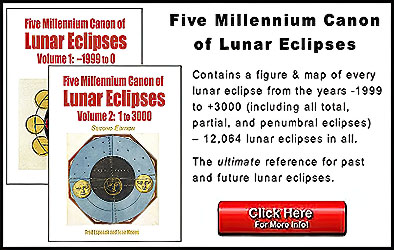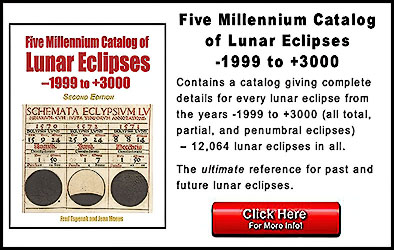apogee - The point along the Moon's orbit that is farthest from Earth; the Moon's mean distance at apogee is 405,504 km; the Moon's true distance at apogee varies from 404,042 to 406,725 km because of gravitational perturbations of the Sun and Earth; See: Moon at Perigee and Apogee: 2001 to 2100.
aphelion - The point along a planetary orbit that is farthest from the Sun; Earth's mean distance at aphelion is 152,097,701 km; Earth's true distance at aphelion varies from 152,083,140 km to 152,104,533 km because of gravitational perturbations of the Sun, Moon and planets; See: Earth at Perihelion and Aphelion: 2001 to 2100.
Besselian elements - The Besselian elements are a series of time dependent variables used to calculate various aspects of a solar eclipse. They describe the movement of the Moon’s shadow with respect to the fundamental plane. This plane passes through the center of Earth and is oriented perpendicular to the Moon’s shadow axis. Next, the shadow cone is projected onto Earth’s surface including the effects of Earth’s rotation, the flattening of Earth and the latitude, longitude and elevation of the observer. The local circumstances at the observer’s position can then be calculated including the eclipse contact times, eclipse magnitude and the duration of totality (or annularity).
central lunar eclipse - A lunar eclipse in which some part of the Moon's disk passes through the axis of Earth's umbral shadow. Central lunar eclipses are always total and they have large umbral eclipse magnitudes, long durations and small values of gamma.
center of figure - The center of figure of a celestial body (e.g., planet, moon) is the apparent center of the object with respect to its surface and takes into account irregularities in its shape. If the distribution of mass is not uniform, then the center of mass does not coincide with the center of figure. In the case of the Moon, the offset between the center of mass and center of figure is ~0.5 kilometers.
center of mass - In orbital mechanics, the equations of motion of celestial bodies (stars, planets, moons, etc.) are formulated as point masses located at the centers of mass. In other words, the motion of a celestial body can be predicted assuming the object’s entire mass is concentrated into one single point called the center of mass.
eclipse duration - The duration of a lunar eclipse is defined as the period between the first and last contact of the Moon's disk with Earth's shadow. The penumbral eclipse duration is measured with respect to the penumbral shadow. The partial eclipse duration is measured with respect to the external contacts with the umbral shadow, while the total eclipse duration is measured with respect to the internal contacts with the umbral shadow.
exeligmos - The exeligmos is a period of 54 years, 33 days and is equal to three saros cycles. It can be used to predict successive eclipses (both solar and lunar) with similar characteristics and geographic location. The duration of the exeligmos is equal to: . . . . 669 synodic months . . . . 725.996 draconic months . . . . 716.976 anomalistic months . . . . 56.996 eclipse years (114 eclipse seasons)
gamma - Gamma is the distance of the center of the Moon’s disk from the center of Earth’s umbral shadow in units of equatorial Earth radii. It is defined at the instant of greatest eclipse when its absolute value is at a minimum.
greatest eclipse - For lunar eclipses, greatest eclipse is defined as the instant when the Moon passes closest to the axis of Earth’s shadow cone.
node - The Moon’s orbit is tipped about 5.1° to Earth’s orbit around the Sun. The two points where the Moon’s orbit crosses Earth’s orbit are called the nodes. The ascending node is where the Moon crosses to the north of Earth’s orbit. The descending node is where it crosses to the south.
partial lunar eclipse - A lunar eclipse in which the Moon passes partly but not completely through Earth’s dark umbral shadow.
penumbra - The penumbra is the weak or pale part of Earth’s shadow. From within the penumbra, the Sun is only partially blocked by Earth as in the case of a penumbral eclipse. This contrasts with the partial and total eclipse, where the Moon partially or completely into Earth’s umbral shadow.
penumbral lunar eclipse -
A lunar eclipse in which the Moon passes through Earth’s penumbral shadow.
During a penumbral eclipse, the shading on the Moon is quite subtle and difficult to see.
From the prospective of an observer on the Moon, Earth appears to be a partially eclipseing the Sun.
penumbral magnitude - Penumbral magnitude is the fraction of the Moon’s diameter occulted by Earth’s penumbral shadow. Eclipse magnitude may be expressed as either a percentage or a decimal fraction (e.g., 50% or 0.50). By convention, its value is given at the instant of greatest eclipse.
perigee - The point along the Moon's orbit that is closest to Earth; the Moon's mean distance at perigee is 363,396 km; the Moon's true distance at perigee varies from 356,355 to 370,399 km because of gravitational perturbations of the Sun and Earth; See: Moon at Perigee and Apogee: 2001 to 2100.
perihelion - The point along a planetary orbit that is closest to the Sun; Earth's mean distance at perihelion is 147,098,074 km; Earth's true distance at perihelion varies from 147,091,358 km to 147,112,452 km because of gravitational perturbations of the Sun, Moon and planets; See: Earth at Perihelion and Aphelion: 2001 to 2100.
saros -
The periodicity and recurrence of solar (and lunar) eclipses is governed by the Saros cycle, a period of approximately 6,585.3d (18yr 11d 8h).
When two eclipses are separated by a period of one Saros, they share a very similar geometry.
The eclipses occur at the same node with the Moon at nearly the same distance from Earth and at the same time of year.
Thus, the Saros is a useful tool for organizing eclipses into families or series.
Each series typically lasts 12 to 15 centuries and contains about 70 to 80.
For more information, see Eclipses and the Saros.
The Saros Catalog of Lunar Eclipses provides complete details for all current Saros cycles.
tetrad - A tetrad is a sequence of four consecutive total lunar eclipses, each separated by six synodic months. Schiaparelli first pointed out that the frequency of tetrads is cyclical with a period of approximately 600 years. During the 21st century, there are eight sets of tetrads.
total lunar eclipse - A lunar eclipse in which the Moon passes completely inside Earth’s dark umbral shadow.
totality - The maximum phase of a total eclipse during which the Moon’s disk passes completely within Earth’s dark umbral shadow.
umbra - The umbra is the darkest part of Earth’s shadow. From within the umbra, all direct sunlight is blocked by Earth as in the case of a total lunar eclipse.
umbral magnitude - Umbral magnitude is the fraction of the Moon’s diameter occulted by Earth’s umbral shadow. Eclipse magnitude may be expressed as either a percentage or a decimal fraction (e.g., 50% or 0.50). By convention, its value is given at the instant of greatest eclipse.
Acknowledgments
This Glossary of Lunar Eclipse Terms is copyright 2015 by Fred Espenak and is part of the EclipsesWise.com web site. No portion of this glossary may be reproduced without the written permission of Fred Espenak along with a link to this page and the following acknowledgment:
"Glossary of Lunar Eclipse Terms by Fred Espenak, www.EclipseWise.com"
EclipseWise Links
- EclipseWise.com - primary page for EclipseWise.com
- EclipseWise Lunar Eclipses - primary page for lunar eclipse predictions
- Lunar Eclipse Links - main directory of links
- EclipseWise Solar Eclipses - primary page for solar eclipse predictions
- Solar Eclipse Links - main directory of links
- EclipseWise Resources - primary page for EclipseWise eclipse-related resources and links
Lunar Eclipse Publications
- Eclipse Almanac: 2021 to 2030 - all solar and lunar eclipses for the decade
- 21st Century Canon of Lunar Eclipses - every lunar eclipse from 2001 through 2100
- Thousand Year Canon of Lunar Eclipses 1501 to 2500 - basic details about every lunar eclipse for 1000 years
- Five Millennium Canon of Lunar Eclipses: -1999 to +3000 - the ultimate reference with maps and diagrams
- Five Millennium Catalog of Lunar Eclipses: -1999 to +3000 - the ultimate reference containing comprehensive tables





